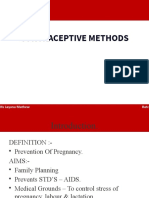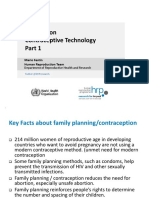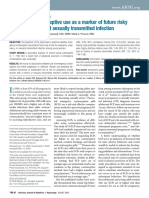FDA OWH BirthControlChart English 2024 11x17 Digital 508
FDA OWH BirthControlChart English 2024 11x17 Digital 508
Uploaded by
carolinephillipsazCopyright:
Available Formats
FDA OWH BirthControlChart English 2024 11x17 Digital 508
FDA OWH BirthControlChart English 2024 11x17 Digital 508
Uploaded by
carolinephillipsazCopyright
Available Formats
Share this document
Did you find this document useful?
Is this content inappropriate?
Copyright:
Available Formats
FDA OWH BirthControlChart English 2024 11x17 Digital 508
FDA OWH BirthControlChart English 2024 11x17 Digital 508
Uploaded by
carolinephillipsazCopyright:
Available Formats
www.fda.
gov/birthcontrol
BIRTH CONTROL GUIDE (CHART)
This birth control chart provides high-level information about different birth control options. It is meant for educational purposes for the
general public. This chart is not meant to be a complete list of all available birth control options. Talk with your health care provider about
the best birth control choice for you.
If you do not want to get pregnant, you can choose from many birth control options. No one product is best for everyone. Some types of birth
control are better than others at preventing pregnancy. Check the pregnancy rates on this chart to get an idea of how effective a method is
at preventing pregnancy. The pregnancy rates on this chart tell you the number of pregnancies expected during the first year of use for each
100 women who use that method. These rates can help you understand how effective the different methods are during actual use (including
sometimes using a method in a way that is not correct or not consistent). The chart also provides some of the risks or side effects associated
with each type of birth control to help you determine which option may be best for you. The only sure way to avoid pregnancy is to not have sex.
NUMBER OF SOME RISKS OR SIDE EFFECTS 4
BIRTH CONTROL METHODS 1 PREGNANCIES USE 3 This chart does not list all of the possible
EXPECTED
risks and side effects.
(per 100 women) 2
Sterilization surgery Less than 1 • One-time procedure • Bleeding • Pain
for women • Permanent • Infection or other
complications after
surgery
Sterilization surgery Less than 1 • One-time procedure • Bleeding • Pain
for men • Permanent • Infection
(vasectomy)
IUD (intrauterine Less than 1 • Inserted and removed by a • Cramps • Spotting between
device)/IUS health care provider • Heavier, longer periods
(intrauterine system) • Lasts up to 10 years periods
without hormone
(copper)
IUD (intrauterine Less than 1 • Inserted and removed by a • Abdominal/pelvic • No periods
device)/IUS health care provider pain (amenorrhea)
(intrauterine system) • Lasts up to 8 years, • Irregular bleeding
with hormone depending on the type
(progestin)
Implantable rod Less than 1 • Inserted and removed by a • Acne • Mood swings or
health care provider • Headache depressed mood
• Lasts up to 3 years • Menstrual changes • Weight gain
Contraceptive 4 • A health care provider gives a • Abdominal • Loss of bone
injection/shot shot every 3 months discomfort density
• Delay in fertility • No periods
return (amenorrhea)
• Headache • Weight gain
• Irregular bleeding/
bleeding between
periods
Oral contraceptives 7 • Must swallow a pill every day • Breast tenderness • Spotting/bleeding
“the pill” • Generally, get a monthly • Headache between periods
(combined pill) period • Nausea
Oral contraceptives 7 • Must swallow a pill every day • Breast tenderness • Spotting/bleeding
“the pill” • Generally, get period less • Headache between periods
(extended/continuous often than monthly
use combined pill) • Nausea
Oral contraceptives 7 • Must swallow a pill at the • Acne • Spotting/bleeding
“the mini pill” same time every day • Breast tenderness between periods
(progestin only) • Generally, get a monthly • Weight gain
• Headache
period
• Nausea
Patch 7 • Put on a new patch • Breast tenderness • Spotting/bleeding
(transdermal system) once a week for 3 weeks • Headache between periods
(wear a patch for 21 • Stomach pain
consecutive days) • Nausea
• Don’t put on a patch during • Skin irritation
the 4th week
Page 1 of 2 May 2024
NUMBER OF SOME RISKS OR SIDE EFFECTS 4
BIRTH CONTROL METHODS 1 PREGNANCIES USE 3
This chart does not list all of the possible
EXPECTED
risks and side effects.
(per 100 women) 2
Vaginal contraceptive 7 • Put the ring into the • Breast tenderness • Vaginal
ring/vaginal vagina yourself • Headache discharge,
contraceptive system • Keep the ring in your vagina discomfort in the
• Nausea vagina, and mild
for 3 weeks and then take it
out for 1 week • Mood changes irritation
• Certain types of rings can be
reused for multiple cycles
Software application 7-8 • Enter the requested • May provide inaccurate information
for contraception information into the app (e.g., (ovulation prediction) if used when
daily basal body temperature, currently or recently on hormonal birth
menstrual cycle information) control or hormonal treatments that
prevent ovulation (release of egg)
Male condom 13 • Must use every time you have • Allergic reactions • Irritation
vaginal sex
• Certain types may provide
protection against some
sexually transmitted
infections (STIs)
Diaphragm with 17 • Must use every time you • Allergic reactions • Urinary tract
spermicide have sex • Irritation infection
Sponge with 17 • Must use every time you • Irritation
spermicide have sex
Cervical cap with 22-23 • Must use every time you • Allergic reactions • Urinary tract
spermicide have sex • Irritation infection
Internal (female) 21 • Must use every time you • Burning sensation, • Discomfort or
condom have vaginal sex rash, or itching pain during
• Provides protection against insertion or sex
some STIs
Anti-sperm vaginal 21-28 • Must use every time you have • Allergic reactions • Urinary tract
contraceptives vaginal sex • Irritation infection
(includes spermicides
and other anti-sperm
agents)
Emergency Contraceptives (EC): May be used if you did not use birth control or if your regular birth control fails (such as a condom
breaks). It should not be used as a regular form of birth control.
Levonorgestrel 7 out of every • Swallow the pill as soon as • Breast pain • Menstrual
1.5 mg (1 pill) 8 women who possible within 3 days after • Dizziness changes
would have having unprotected sex • Nausea
gotten pregnant • Headache
will not become • Lower stomach • Tiredness
pregnant after (abdominal) pain • Vomiting
taking this EC
Ulipristal acetate 6 or 7 out of • Swallow the pill(s) as soon as • Abdominal pain • Menstrual pain
every 10 women possible within 5 days after • Dizziness • Nausea
who would have having unprotected sex
gotten pregnant • Headache • Tiredness
will not become
pregnant after
taking this EC
1
Consumers should be aware that FDA approves, clears, and grants marketing authorization for individual contraceptive products, not “methods.”
However, for purposes of this chart, which includes birth control options broader than products, we use the term “methods.”
2
Data is drawn from Bradley SEK, et al., Effectiveness, safety, and comparative side effects. In: Cason P, Cwiak C, Edelment A, et al. [Eds.]
Contraceptive Technology. 22nd edition. Burlington, MA: Jones-Bartlett Learning, 2023; in instances where clinical trial data described in FDA
required labeling showed higher pregnancy rates, that information is also provided. For more information on the chance of getting pregnant while
using a certain product (medicine or device), please check the product label or consult your health care provider.
Learn more:
3
Refer to the Prescribing Information or instructions for use for a specific product or ask your health care provider for specific instructions for use.
4
The risks and side effects are listed in alphabetical order; the information on this chart does not include all risks and benefits for each method.
Page 2 of 2 May 2024
You might also like
- ContraceptionDocument53 pagesContraceptionfiea241089100% (7)
- Botros Rizk Mostafa A Borahay Abdel Maguid Ramzy Clinical DiagnosisDocument232 pagesBotros Rizk Mostafa A Borahay Abdel Maguid Ramzy Clinical DiagnosisValentin Rodrigo100% (2)
- Women'S Health Talk Kozri Lo Lasante Madanm: DR Annabelle D. Marie MO Ministry of Health SeychellesDocument32 pagesWomen'S Health Talk Kozri Lo Lasante Madanm: DR Annabelle D. Marie MO Ministry of Health SeychellesAnna Diana Maria100% (1)
- 6 ContraceptionDocument51 pages6 ContraceptionkaisNo ratings yet
- The Sexual Self Family PlanningDocument28 pagesThe Sexual Self Family PlanningShane UretaNo ratings yet
- Poster English June 2013Document1 pagePoster English June 2013Fentahun workieNo ratings yet
- Family Planning MethodsDocument21 pagesFamily Planning MethodsLady MayNo ratings yet
- Family Planing ProductDocument1 pageFamily Planing Producttemidayojimoh07No ratings yet
- Contraception Options in New ZealandDocument2 pagesContraception Options in New ZealandStuff Newsroom100% (1)
- Family Planning1Document63 pagesFamily Planning1Deborah AmpongNo ratings yet
- Contraceptive Assignment AdihailuDocument46 pagesContraceptive Assignment AdihailuAbas AhmedNo ratings yet
- Abnormal Uterine Bleeding - ACOGDocument10 pagesAbnormal Uterine Bleeding - ACOGAaronNo ratings yet
- Fam PlanningDocument2 pagesFam PlanningGerald AlNo ratings yet
- Contraception & Birth Control MethodsDocument49 pagesContraception & Birth Control MethodsStephen BatureNo ratings yet
- Contraceptive Methods Bio ProjectDocument8 pagesContraceptive Methods Bio ProjectMr. CrustNo ratings yet
- Contraceptions (COC Pills, Emergency Contraceptive Pills, POP)Document43 pagesContraceptions (COC Pills, Emergency Contraceptive Pills, POP)Ether EtherNo ratings yet
- Lec 4 Family Planning ProgramDocument23 pagesLec 4 Family Planning ProgramJohn Carlo ReyesNo ratings yet
- ContraceptiveOptions PDFDocument4 pagesContraceptiveOptions PDFRishabh SinghNo ratings yet
- Instruction Pad Coc Pill Sept 2014Document2 pagesInstruction Pad Coc Pill Sept 2014Divina MantaryoNo ratings yet
- ENDOMETRIOSISDocument13 pagesENDOMETRIOSISAngel SaraNo ratings yet
- ContraceptionDocument34 pagesContraceptionMimo HemadNo ratings yet
- Start A Method Today.: Choosing A Method: What Matters Most To Me?Document1 pageStart A Method Today.: Choosing A Method: What Matters Most To Me?nkuligowskiNo ratings yet
- How Can You Help Your Patients With An Uncomplicated UTI?: Know?Document1 pageHow Can You Help Your Patients With An Uncomplicated UTI?: Know?gegeNo ratings yet
- 13 FPDocument32 pages13 FPDawit g/kidanNo ratings yet
- Chapter 01 EngDocument28 pagesChapter 01 EngAmit GuptaNo ratings yet
- Contraception and Women Health 2 1Document18 pagesContraception and Women Health 2 1nusaiba0313No ratings yet
- Birth Control Pill: (Depot Medroxyprogesterone Acetate, DMPA)Document1 pageBirth Control Pill: (Depot Medroxyprogesterone Acetate, DMPA)Himadri LalNo ratings yet
- YonivyapadasDocument183 pagesYonivyapadasNilu BhoiNo ratings yet
- Module 2. Block 3. Unit 2Document64 pagesModule 2. Block 3. Unit 2Bhaskar PandeyNo ratings yet
- C2 Family PlanningDocument35 pagesC2 Family PlanningJency NithishajiNo ratings yet
- Misoprostol For Treatment of Early Pregnancy LossDocument2 pagesMisoprostol For Treatment of Early Pregnancy LossJuan KipronoNo ratings yet
- ContaceptionDocument66 pagesContaceptionSadaf AfzalNo ratings yet
- What Are Contraceptives? Emergency Contraceptives Pill: Non-Drug Technique Drug TherapyDocument3 pagesWhat Are Contraceptives? Emergency Contraceptives Pill: Non-Drug Technique Drug TherapyredsoulthreeNo ratings yet
- Hormonal Implants: Pros ConsDocument11 pagesHormonal Implants: Pros ConsJeffrey XieNo ratings yet
- Reproduction and Birth ControlDocument28 pagesReproduction and Birth ControlAthena CrooksNo ratings yet
- Hormonal Contraception Webinar KOGS 13.10Document44 pagesHormonal Contraception Webinar KOGS 13.10Alice KaariaNo ratings yet
- Module 4 - Contraception and Family PlanningDocument18 pagesModule 4 - Contraception and Family PlanningKath NambuNo ratings yet
- Patient Information: Uterine Fibroids (The Basics) : Written by The Doctors and Editors at UptodateDocument4 pagesPatient Information: Uterine Fibroids (The Basics) : Written by The Doctors and Editors at UptodateYong Fang YueNo ratings yet
- Reproductive Health PowerNotes by KT SirDocument2 pagesReproductive Health PowerNotes by KT Sirjumihuss08No ratings yet
- Presentation1-Family PlanningDocument29 pagesPresentation1-Family PlanningtabacocitymentalhealthofficeNo ratings yet
- ContraceptionDocument71 pagesContraceptionMark CalawayNo ratings yet
- Biology: Reproduction in HumansDocument11 pagesBiology: Reproduction in HumansGunaraman LicNo ratings yet
- Coc 1Document17 pagesCoc 1Ahmed AnwarNo ratings yet
- Pil 1494Document2 pagesPil 1494dr.barraq88No ratings yet
- ContraceptionDocument43 pagesContraceptionShivani TiwariNo ratings yet
- Emergency ContraceptionDocument23 pagesEmergency ContraceptionNithiya NadesanNo ratings yet
- ContrceptionDocument33 pagesContrceptionteslainterstellarNo ratings yet
- Lecture 18family PlanningDocument44 pagesLecture 18family PlanningSulaiman SanusiNo ratings yet
- Appendices: Tools For Clients and Providers Information For ProvidersDocument24 pagesAppendices: Tools For Clients and Providers Information For ProvidersLazel Ann Picon CruzNo ratings yet
- Contraception CMEDocument57 pagesContraception CMEstephaniesoniamethewNo ratings yet
- ContraceptivesDocument19 pagesContraceptivesTamoya ShirleyNo ratings yet
- Uk-Pl-CleanDocument1 pageUk-Pl-CleanI Made AryanaNo ratings yet
- Reproductive Health SummaryDocument5 pagesReproductive Health Summarystutishukla2005No ratings yet
- Progestin-Only Injectables Fact Sheet Final - 102510Document2 pagesProgestin-Only Injectables Fact Sheet Final - 102510Chan Myae AungNo ratings yet
- OralContraceptives WebDocument4 pagesOralContraceptives WebtheTomBoy_PrincessNo ratings yet
- Abortion DetailsDocument16 pagesAbortion Detailsmickey2020No ratings yet
- Updates Contraceptive Technology Part1 Festin 2017Document88 pagesUpdates Contraceptive Technology Part1 Festin 2017Isi OtomatisNo ratings yet
- What You Need To Know Before You Use Predsol Retention EnemaDocument2 pagesWhat You Need To Know Before You Use Predsol Retention EnemalalaNo ratings yet
- Iud Pamphlet June 2015Document2 pagesIud Pamphlet June 2015Aprilihardini LaksmiNo ratings yet
- Syed FPDocument65 pagesSyed FPMushfiq RahmanNo ratings yet
- General Biology 1: Quarter 1 - Module 4Document4 pagesGeneral Biology 1: Quarter 1 - Module 4karyo eseymNo ratings yet
- Sander 2009Document6 pagesSander 2009Rika Yulizah GobelNo ratings yet
- Teenage Pregnancy Is Not A BlessingDocument15 pagesTeenage Pregnancy Is Not A BlessingEryll Eunice VillaganasNo ratings yet
- Khatti Meethi BaateDocument17 pagesKhatti Meethi BaateICSE ClassNo ratings yet
- American Baby: A Mother, A Child, and The Shadow History of AdoptionDocument10 pagesAmerican Baby: A Mother, A Child, and The Shadow History of AdoptionOnPointRadioNo ratings yet
- Script For Leopold's Maneuver (Autorecovered)Document3 pagesScript For Leopold's Maneuver (Autorecovered)lea mae andoloyNo ratings yet
- Nueva Tec Ovh VacasDocument8 pagesNueva Tec Ovh VacasAndres Luna MendezNo ratings yet
- Q2 G5 Science M1Document33 pagesQ2 G5 Science M1Maricar AtienzaNo ratings yet
- Chapter 2 by Ivy and RacelDocument15 pagesChapter 2 by Ivy and RacelKarl DitanNo ratings yet
- History Taking and Physical Examination in Gyn-ObsDocument10 pagesHistory Taking and Physical Examination in Gyn-ObsBeakal TsegaiNo ratings yet
- Relevance of Menarche, Menopause, and Other Bioevent To FertilityDocument3 pagesRelevance of Menarche, Menopause, and Other Bioevent To FertilitydattaniranjanNo ratings yet
- Semen Analysis - Aubf (BSMLS Olfu)Document8 pagesSemen Analysis - Aubf (BSMLS Olfu)Mitch IbayNo ratings yet
- Artificial Reproductive Technologies: Zygote Intrafallopian Transfer (ZIFT) Is ADocument4 pagesArtificial Reproductive Technologies: Zygote Intrafallopian Transfer (ZIFT) Is AWarp RealityNo ratings yet
- Full Download Newer Trends in Art 1st Edition Nandita Palshetkar PDFDocument64 pagesFull Download Newer Trends in Art 1st Edition Nandita Palshetkar PDFomlipasonNo ratings yet
- Integrated Management of Pregnancy and ChildbirthDocument16 pagesIntegrated Management of Pregnancy and ChildbirthLea Foy-os CapiliNo ratings yet
- Snowflakes FactsDocument13 pagesSnowflakes FactsAbigail LorenzanaNo ratings yet
- Evaluation of Hamilton Thorn Automated Semen Analysis SystemDocument11 pagesEvaluation of Hamilton Thorn Automated Semen Analysis SystemShabbir HussainNo ratings yet
- Margaret Sanger Essay ThesisDocument6 pagesMargaret Sanger Essay ThesisPayPeopleToWritePapersUK100% (2)
- Pajarillo Davey Mharz Gen Bio 1 WorksheetDocument12 pagesPajarillo Davey Mharz Gen Bio 1 Worksheetpajarillodaveymharz29No ratings yet
- 2092 5381 1 PBDocument6 pages2092 5381 1 PBnamiraNo ratings yet
- The Orgasm in WomanDocument4 pagesThe Orgasm in Woman517wangyiqiNo ratings yet
- The Word of Allah Ta'ala in Sura Al-Baqarah Verse 223Document4 pagesThe Word of Allah Ta'ala in Sura Al-Baqarah Verse 223Nor Aini ZahraNo ratings yet
- Wa0016.Document1 pageWa0016.aliaa.hamzaNo ratings yet
- Informe PericialDocument3 pagesInforme PericialEDGAR VILLARROELNo ratings yet
- Reyes, Christina Katelyn L. Feu-Nrmf Batch 2019, Liora Community Health NursingDocument10 pagesReyes, Christina Katelyn L. Feu-Nrmf Batch 2019, Liora Community Health NursingSeanmarie CabralesNo ratings yet
- Management of Woman During First Stage of Labour Management of Woman During First Stage of LabourDocument21 pagesManagement of Woman During First Stage of Labour Management of Woman During First Stage of LabourKinjal Vasava75% (4)
- How To Measure Cervical Length: Karl Oliver Kagan and Jiri SonekDocument14 pagesHow To Measure Cervical Length: Karl Oliver Kagan and Jiri SoneknidoNo ratings yet
- Edical Termination OF Pregnancy: MTP ACT, 1971Document3 pagesEdical Termination OF Pregnancy: MTP ACT, 1971Menka MadanNo ratings yet
- 10-Seminal Fluid AnalysisDocument69 pages10-Seminal Fluid AnalysisAhmed AliNo ratings yet

























































































